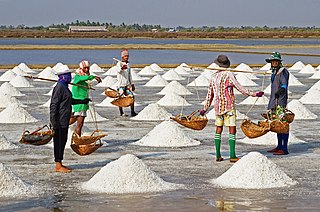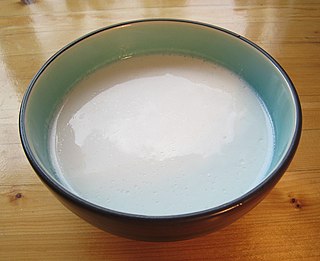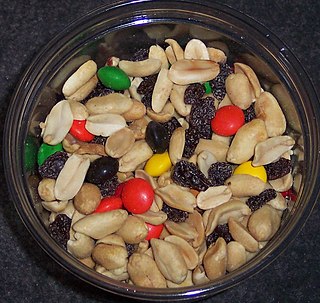
Bubble tea is a tea-based drink that originated in Taiwan in the early 1980s. Taiwanese immigrants brought it to the United States in the 1990s, initially in California through regions including Los Angeles County, but the drink has also spread to other countries where there is a large East Asian diaspora population.

Dessert is a course that concludes a meal. The course consists of sweet foods, such as cake, biscuit, ice cream and possibly a beverage such as dessert wine and liqueur. Some cultures sweeten foods that are more commonly savory to create desserts. In some parts of the world there is no tradition of a dessert course to conclude a meal.

Thai cuisine is the national cuisine of Thailand.

Sea salt is salt that is produced by the evaporation of seawater. It is used as a seasoning in foods, cooking, cosmetics and for preserving food. It is also called bay salt, solar salt, or simply salt. Like mined rock salt, production of sea salt has been dated to prehistoric times.

A milkshake is a sweet beverage made by blending milk, ice cream, and flavorings or sweeteners such as butterscotch, caramel sauce, chocolate syrup, or fruit syrup into a thick, sweet, cold mixture. It may also be made using a base made from non-dairy products, including plant milks such as almond milk, coconut milk, or soy milk. Dry ingredients such as whole fruit, nuts, seeds, candy, or cookies may be incorporated.

Eggnog, historically also known as a milk punch or an egg milk punch when alcoholic beverages are added, is a rich, chilled, sweetened, dairy-based beverage. It is traditionally made with milk, cream, sugar, egg yolks, and whipped egg whites. A distilled spirit such as brandy, rum, whiskey or bourbon is often a key ingredient.

Coconut milk is an opaque, milky-white liquid extracted from the grated pulp of mature coconuts. The opacity and rich taste of coconut milk are due to its high oil content, most of which is saturated fat. Coconut milk is a traditional food ingredient used in Southeast Asia, Oceania, South Asia, and East Africa. It is also used for cooking in the Caribbean, tropical Latin America, and West Africa, where coconuts were introduced during the colonial era.

Canadian cuisine consists of the cooking traditions and practices of Canada, with regional variances around the country. First Nations and Inuit have practiced their culinary traditions in what is now Canada since at least 15,000 years ago. The advent of European explorers and settlers, first on the east coast and then throughout the wider territories of New France, British North America and Canada, saw the melding of foreign recipes, cooking techniques, and ingredients with indigenous flora and fauna. Modern Canadian cuisine has maintained this dedication to local ingredients and terroir, as exemplified in the naming of specific ingredients based on their locale, such as Malpeque oysters or Alberta beef. Accordingly, Canadian cuisine privileges the quality of ingredients and regionality, and may be broadly defined as a national tradition of "creole" culinary practices, based on the complex multicultural and geographically diverse nature of both historical and contemporary Canadian society.

Milo is a chocolate-flavoured malted powder product produced by Nestlé, typically mixed with milk, hot water, or both, to produce a beverage. It was originally developed in Australia by Thomas Mayne (1901–1995) in 1934.

Heston Marc Blumenthal is an English celebrity chef, TV personality and food writer. Blumenthal is regarded as a pioneer of multi-sensory cooking, food pairing and flavour encapsulation. He came to public attention with unusual recipes, such as bacon-and-egg ice cream and snail porridge. His recipes for triple-cooked chips and soft-centred Scotch eggs have been widely imitated. He has advocated a scientific approach to cooking, for which he has been awarded honorary degrees from the universities of Reading, Bristol and London and made an honorary Fellow of the Royal Society of Chemistry.

Filipino cuisine is composed of the cuisines of more than a hundred distinct ethnolinguistic groups found throughout the Philippine archipelago. A majority of mainstream Filipino dishes that compose Filipino cuisine are from the food traditions of various ethnolinguistic groups and tribes of the archipelago, including the Ilocano, Pangasinan, Kapampangan, Tagalog, Bicolano, Visayan, Chavacano, and Maranao ethnolinguistic groups. The dishes associated with these groups evolved over the centuries from a largely indigenous base shared with maritime Southeast Asia with varied influences from Chinese, Spanish, and American cuisines, in line with the major waves of influence that had enriched the cultures of the archipelago, and adapted using indigenous ingredients to meet local preferences.

Plant milk is a plant beverage with a color resembling that of milk. Plant milks are non-dairy beverages made from a water-based plant extract for flavoring and aroma. Plant milks are consumed as alternatives to dairy milk, and may provide a creamy mouthfeel.

A milk substitute is any substance that resembles milk and can be used in the same ways as milk. Such substances may be variously known as non-dairy beverage, nut milk, grain milk, legume milk, mock milk and alternative milk.

Regional street food is street food that has commonalities within a region or culture.

A snack is a small portion of food generally eaten between meals. A snack is often less than 200 calories, but this can vary. Snacks come in a variety of forms including packaged snack foods and other processed foods, as well as items made from fresh ingredients at home.
Stew peas is a Jamaican stew prepared using coconut milk, beans and salted meat. It is a common dish in Jamaica.

Activated charcoal cleanses, also known as charcoal detoxes, are a pseudoscientific use of a proven medical intervention. Activated charcoal is available in powder, tablet and liquid form. Its proponents claim the use of activated charcoal on a regular basis will detoxify and cleanse the body as well as boost one's energy and brighten the skin. Such claims violate basic principles of chemistry and physiology. There is no medical evidence for any health benefits of cleanses or detoxes via activated charcoal or any other method. Charcoal, when ingested, will absorb vitamins and nutrients as well as prescription medications present in the gastrointestinal tract which can make it dangerous to use unless directed by a medical doctor.

















